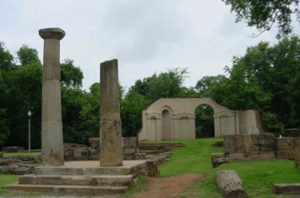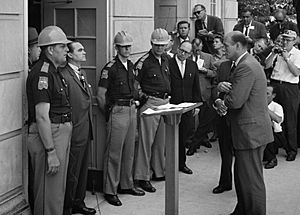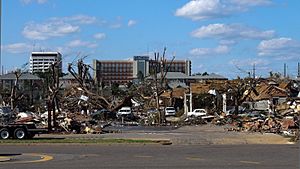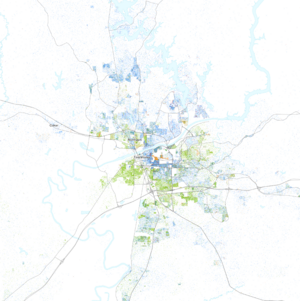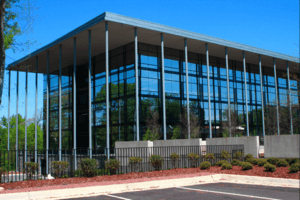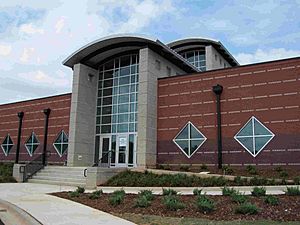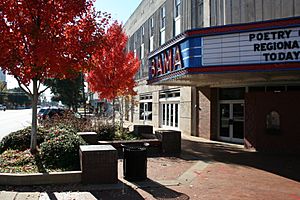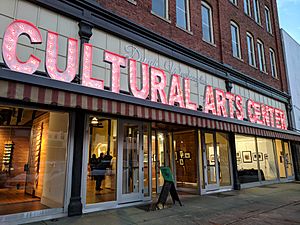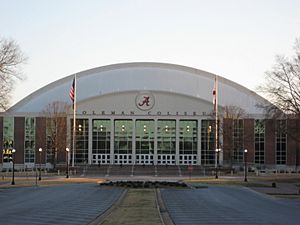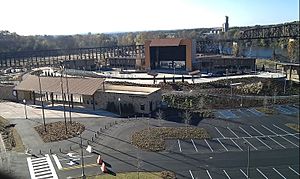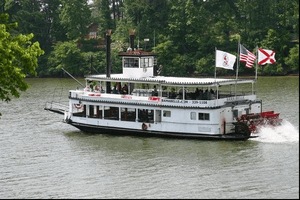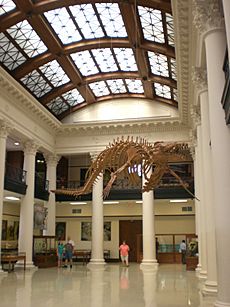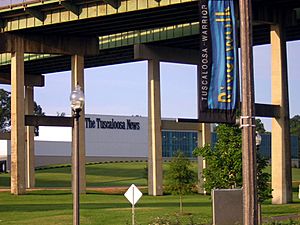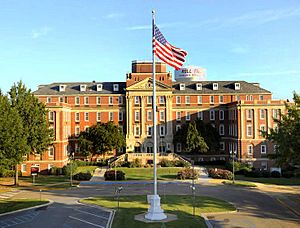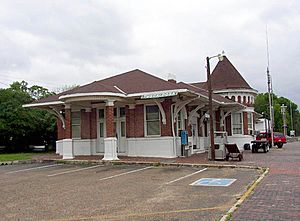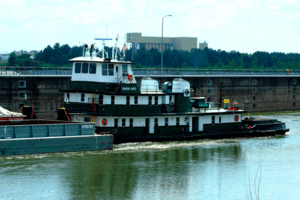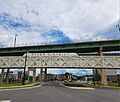Tuscaloosa, Alabama facts for kids
Quick facts for kids
Tuscaloosa
|
|||||
|---|---|---|---|---|---|
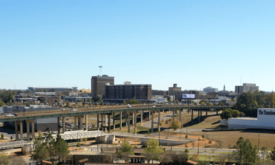
View of Downtown Tuscaloosa from the amphitheater
|
|||||
|
|||||
| Nickname(s):
Druid City, T-Town, City of Champions
|
|||||
| Motto(s):
"Together we can build a bridge to the future."
|
|||||

Location of Tuscaloosa in Tuscaloosa County, Alabama
|
|||||
| Country | United States | ||||
| State | Alabama | ||||
| County | Tuscaloosa | ||||
| Incorporated | December 13, 1819 | ||||
| Government | |||||
| • Type | Mayor-Council | ||||
| Area | |||||
| • City | 72.22 sq mi (187.05 km2) | ||||
| • Land | 62.15 sq mi (160.97 km2) | ||||
| • Water | 10.07 sq mi (26.08 km2) | ||||
| Elevation | 221 ft (69 m) | ||||
| Population
(2023)
|
|||||
| • City | 99,600 | ||||
| • Estimate
(2023)
|
111,338 | ||||
| • Rank | US: 280th AL: 5th |
||||
| • Density | 1,787/sq mi (689.9/km2) | ||||
| • Urban | 156,450 (US: 229th) | ||||
| • Urban density | 1,774.6/sq mi (685.2/km2) | ||||
| • Metro | 277,494 (US: 181st) | ||||
| • Metro density | 79.4/sq mi (30.67/km2) | ||||
| Time zone | UTC−6 (Central (CST)) | ||||
| • Summer (DST) | UTC−5 (CDT) | ||||
| ZIP Codes |
35401, 35402, 35403, 35404, 35405, 35406, 35407, 35486, 35487
|
||||
| Area code(s) | 205 and 659 | ||||
| FIPS code | 01-77256 | ||||
| GNIS feature ID | 0153742 | ||||
Tuscaloosa is a city in west-central Alabama, United States. It is the main city of Tuscaloosa County. The city sits along the Black Warrior River. It is Alabama's fifth-largest city. In 2020, about 99,600 people lived there. By 2023, this number grew to an estimated 111,338.
Tuscaloosa was called Tuskaloosa until the early 1900s. It is also known as "the Druid City." This is because many water oak trees were planted in its downtown streets starting in the 1840s. The city was officially formed on December 13, 1819. It was named after Tuskaloosa, a Native American chief. His people were defeated by Spanish explorer Hernando de Soto in 1540. Tuscaloosa was Alabama's capital city from 1826 to 1846. The capital then moved to Montgomery.
Today, Tuscaloosa is a major center for business, healthcare, and education in West Alabama. It is the main city of the Tuscaloosa Metropolitan Statistical Area. This area includes Tuscaloosa, Hale, and Pickens counties.
The city is home to the University of Alabama, Stillman College, and Shelton State Community College. The University of Alabama is a huge part of the city's economy and culture. This makes Tuscaloosa a "college town." The city is also called "The City of Champions." This nickname came after the Alabama Crimson Tide football team won many national championships. They won in 2009, 2011, 2012, 2015, 2017, and 2020. In 2008, Tuscaloosa also hosted the USA Olympic Triathlon trials for the Beijing Games.
Contents
History of Tuscaloosa
Early Native American Life
In 1828, Andrew Jackson became president. He was popular for winning battles, including against the Creek people in 1814. President Jackson wanted to move all Native American tribes living east of the Mississippi River. This would free up land for European-American settlers.
After the Indian Removal Act was passed, the Creek National Council signed a treaty in 1832. They gave up their lands east of the Mississippi to the U.S. They agreed to move to the Indian Territory. Most Muscogee-speaking people were moved during the Trail of Tears in 1834. Some Muscogee still live in Alabama today.
Becoming a State and City Name
After the War of 1812, more white settlers moved into the Southeast. They settled on land that used to belong to Native Americans. A small group of log cabins appeared near a large Creek village. The settlers named their new town Tuskaloosa. They honored the 16th-century Chief Tuskaloosa. His name comes from Choctaw words meaning "warrior" and "black."
In 1817, Alabama became a territory. On December 13, 1819, Tuskaloosa became an official town. This was one day before Congress made Alabama a state.
From 1826 to 1846, Tuskaloosa was the capital of Alabama. The State House was built where Capitol Park is now. In 1831, the University of Alabama was started. The town grew quickly. But when the capital moved to Montgomery, the city faced hard times. The state then built the Alabama State Hospital for the Insane in the 1850s. This helped Tuscaloosa's economy recover.
Civil War and Growth
During the Civil War, many men from Tuscaloosa fought for the Confederate armies. Near the end of the war, the university campus was burned in a battle. The town was also damaged. White residents faced economic hardship. Black residents were freed from slavery.
In the 1890s, new locks and dams were built on the Black Warrior River. This made it easier for boats to travel. Tuscaloosa became connected to the port of Mobile. This helped the economy grow. Mining and metal industries started in the area. By the 1900s, the University of Alabama and healthcare facilities grew. This, along with a strong national economy, helped Tuscaloosa grow steadily for 100 years.
Civil Rights Movement
After World War II, African Americans worked hard for their rights. They challenged segregation in the South. In 1952, Autherine Lucy was accepted into the university. But her acceptance was taken back because she was not white. After three years, a court ordered the university to allow Lucy and another student to enroll.
On February 3, 1956, Lucy became the first African American to attend a white public university in Alabama. On February 6, students and others rioted on campus. A large crowd threw things at the car taking her to class. The university then suspended Lucy, saying it was for her safety. She was later expelled. In 1988, the university canceled her expulsion. Lucy returned and finished her degree in 1992, graduating with her daughter.
On June 11, 1963, George Wallace, the governor of Alabama, stood in front of Foster Auditorium. This event was called the Stand in the Schoolhouse Door. He tried to stop two African-American students, Vivian Malone and James Hood, from enrolling. When confronted by federal officials, Wallace stepped aside. President John F. Kennedy supported the university's integration.
On June 9, 1964, an event known as Bloody Tuesday happened. Peaceful African-American civil rights marchers were beaten, arrested, and tear-gassed by police. They were walking to the First African Baptist Church to protest segregated restrooms. Many people were hurt, and 94 were arrested.
James Hood left the university but returned later. In 1997, he earned his Ph.D. Vivian Malone stayed and became the first African American to graduate from the university. In 2000, she received an honorary degree. Later in his life, Governor Wallace apologized for his actions against integration.
In 2010, the university honored Lucy, Hood, and Malone. They renamed the plaza in front of Foster Auditorium as Malone-Hood Plaza. They also built the Autherine Lucy Clock Tower there.
2011 Tornado Devastation
On April 27, 2011, a very strong EF4 tornado hit Tuscaloosa. It was about 1.5 miles (2.4 km) wide. This tornado caused 64 deaths and over 1,500 injuries. Most of the deaths, 44, were in Tuscaloosa. The tornado's winds were estimated at 190 miles per hour (306 km/h). Mayor Walter Maddox said that some neighborhoods were "removed from the map." This tornado also caused major damage in the Birmingham area. The total cost of damage was $2.45 billion. At the time, it was the most expensive tornado in U.S. history.
The tornado was part of the 2011 Super Outbreak. This was the largest tornado outbreak ever recorded in the eastern United States. In total, 324 people died from tornadoes during this outbreak. Over 20% of the damage cost came from the Tuscaloosa tornado.
After the tornado, thousands of rescue workers searched through the wreckage. Many people were listed as missing, but most were later found alive. President Barack Obama and Alabama Governor Robert Bentley visited Tuscaloosa. They toured the damaged areas and promised federal help for recovery. Many organizations and famous people also donated money and supplies to help.
Due to the disaster, the University of Alabama held a delayed graduation ceremony in August 2011. They gave degrees to six students who died in the tornado.
Bicentennial Celebration
The city of Tuscaloosa turned 200 years old on December 13, 2019. City officials held many special events. These included showing a "bicentennial quilt" and a fireworks display. The University of Alabama gave two sculptures to the city. One was a large statue of the Roman goddess Minerva. The other was "The Walkway," which shows the path of the Black Warrior River.
A time capsule was buried near Manderson Landing. It contains items from 2019. It will be opened on December 13, 2069, for the city's 250th birthday.
Geography and Climate
City Location and Features
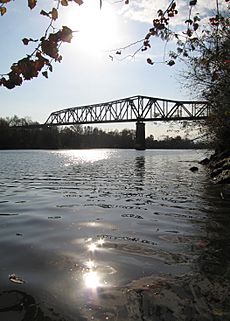
Tuscaloosa covers about 70.3 square miles (182.1 km2). About 60.2 square miles (155.9 km2) is land, and 10.1 square miles (26.2 km2) is water. Most of the water is in Lake Tuscaloosa and the Black Warrior River.
The city is about 60 miles (97 km) southwest of Birmingham. It is located where the Black Warrior River flows from rocky hills to a flat, marshy plain. This gives the area diverse landscapes.
Major parts of Tuscaloosa include West Tuscaloosa, Downtown, the University of Alabama campus, and Alberta City.
Weather Patterns
Tuscaloosa has a humid subtropical climate. This means it has hot, humid summers and mild winters. The Gulf of Mexico brings warm, moist air to the region. This air mixes with cooler air from the North, causing rain.
Severe thunderstorms can happen, bringing strong winds, large hail, and sometimes tornadoes. An F4 tornado hit Tuscaloosa County in December 2000. Another F2 tornado hit in January 1997. In April 2011, two tornadoes struck the city. The second one was an EF4, causing many deaths and damage.
Winter is from mid-December to late-February. Snowfall is rare. Summers are from mid-May to mid-September, with hot temperatures. The highest temperature ever recorded was 107°F (42°C) in July 1952 and August 2007. The lowest was -1°F (-18°C) in January 1985.
| Climate data for Tuscaloosa, Alabama (Tuscaloosa Regional Airport), 1991–2020 normals, extremes 1948–present | |||||||||||||
|---|---|---|---|---|---|---|---|---|---|---|---|---|---|
| Month | Jan | Feb | Mar | Apr | May | Jun | Jul | Aug | Sep | Oct | Nov | Dec | Year |
| Record high °F (°C) | 82 (28) |
86 (30) |
88 (31) |
94 (34) |
98 (37) |
105 (41) |
107 (42) |
107 (42) |
104 (40) |
101 (38) |
89 (32) |
82 (28) |
107 (42) |
| Mean daily maximum °F (°C) | 55.7 (13.2) |
60.2 (15.7) |
68.3 (20.2) |
75.5 (24.2) |
83.0 (28.3) |
89.2 (31.8) |
91.6 (33.1) |
91.2 (32.9) |
87.0 (30.6) |
76.9 (24.9) |
65.6 (18.7) |
57.9 (14.4) |
75.2 (24.0) |
| Daily mean °F (°C) | 45.7 (7.6) |
49.6 (9.8) |
56.9 (13.8) |
63.8 (17.7) |
72.2 (22.3) |
79.1 (26.2) |
81.9 (27.7) |
81.5 (27.5) |
76.3 (24.6) |
65.2 (18.4) |
54.2 (12.3) |
48.0 (8.9) |
64.5 (18.1) |
| Mean daily minimum °F (°C) | 35.7 (2.1) |
38.9 (3.8) |
45.5 (7.5) |
52.0 (11.1) |
61.3 (16.3) |
69.0 (20.6) |
72.3 (22.4) |
71.7 (22.1) |
65.6 (18.7) |
53.4 (11.9) |
42.8 (6.0) |
38.2 (3.4) |
53.9 (12.2) |
| Record low °F (°C) | −1 (−18) |
5 (−15) |
12 (−11) |
29 (−2) |
36 (2) |
45 (7) |
54 (12) |
53 (12) |
37 (3) |
23 (−5) |
10 (−12) |
2 (−17) |
−1 (−18) |
| Average precipitation inches (mm) | 4.97 (126) |
5.37 (136) |
4.82 (122) |
5.00 (127) |
3.64 (92) |
4.67 (119) |
4.17 (106) |
4.36 (111) |
3.40 (86) |
3.54 (90) |
4.52 (115) |
5.06 (129) |
53.52 (1,359) |
| Average precipitation days (≥ 0.01 in) | 10.3 | 10.8 | 10.8 | 8.9 | 9.4 | 9.9 | 11.1 | 10.7 | 7.6 | 8.7 | 8.8 | 10.7 | 117.7 |
| Source: NOAA | |||||||||||||
People of Tuscaloosa
| Historical population | |||
|---|---|---|---|
| Census | Pop. | %± | |
| 1840 | 1,949 | — | |
| 1850 | 3,500 | 79.6% | |
| 1860 | 3,989 | 14.0% | |
| 1870 | 1,689 | −57.7% | |
| 1880 | 2,418 | 43.2% | |
| 1890 | 4,215 | 74.3% | |
| 1900 | 5,094 | 20.9% | |
| 1910 | 8,407 | 65.0% | |
| 1920 | 11,996 | 42.7% | |
| 1930 | 20,659 | 72.2% | |
| 1940 | 27,493 | 33.1% | |
| 1950 | 46,396 | 68.8% | |
| 1960 | 63,370 | 36.6% | |
| 1970 | 65,773 | 3.8% | |
| 1980 | 75,211 | 14.3% | |
| 1990 | 77,759 | 3.4% | |
| 2000 | 77,906 | 0.2% | |
| 2010 | 90,468 | 16.1% | |
| 2020 | 99,600 | 10.1% | |
| 2022 (est.) | 110,602 | 22.3% | |
| U.S. Decennial Census 2020 Census |
|||
As of the 2020 Census, Tuscaloosa had 99,600 people. There were 36,779 households and 20,176 families living in the city.
The city's population was made up of different groups:
| Race | Num. | Perc. |
|---|---|---|
| White | 47,663 | 47.85% |
| Black or African American | 40,867 | 41.03% |
| Native American | 147 | 0.15% |
| Asian | 2,352 | 2.36% |
| Pacific Islander | 47 | 0.05% |
| Other/Mixed | 3,086 | 3.1% |
| Hispanic or Latino | 5,438 | 5.46% |
In 2010, the city had 90,468 people. About 53.8% were White, and 41.5% were Black or African American. About 3.0% of the population was Hispanic or Latino. The average age in the city was 25.4 years.
Religious Communities
Tuscaloosa has many places of worship. The main religion is Southern Baptist. There are also Catholic, Presbyterian, Lutheran, and Unitarian Universalist churches. The city has a Jewish community with a synagogue and a Hillel center. There is also a Hindu temple and an Islamic center.
Economy and Jobs
Tuscaloosa's economy is strong in higher education. But it also has many jobs in manufacturing and services. About 25% of workers in the Tuscaloosa area work for the government. Other large job areas include manufacturing (16.7%), retail and transportation (16.4%), and finance (11.6%). Education and healthcare make up 7.2% of jobs.
The city has many factories. These include BFGoodrich Tire Manufacturing, GAF Materials Corporation, and Nucor Steel.
A big part of the economy is the Mercedes-Benz U.S. International plant. It is near Vance, about 20 miles (32 km) east of downtown Tuscaloosa. This plant opened in 1995 and employs about 4,400 people. It builds different Mercedes-Benz vehicles. Other companies that supply parts to Mercedes-Benz are also in the area.
The Westervelt Company, which manages land and wildlife, has its main office in Tuscaloosa. Healthcare and education are also very important. Major employers include the University of Alabama, DCH Regional Medical Center, and Bryce Hospital.
Arts and Culture in Tuscaloosa
Libraries and Museums
The Tuscaloosa Public Library serves both the city and county. It has almost 200,000 items. There are three branches: the Main branch, the Weaver-Bolden branch, and the Brown branch.
The University of Alabama, Stillman College, and Shelton State Community College also have libraries. These are open to the public for reading and research.
Tuscaloosa has several museums. In downtown, you can find CHOM: the Children's Hands-On Museum and the Murphy African-American Museum. On the University of Alabama campus, there is the Alabama Museum of Natural History and the Paul W. Bryant Museum. The Jones Archaeological Museum is about 15 miles (24 km) south of Tuscaloosa. It is located at the Moundville Archaeological Park.
Performing Arts Venues
Tuscaloosa is home to many performing arts groups. Some are linked to the University of Alabama or Shelton State. Others are independent, like the Tuscaloosa Community Theater. These groups work together through the Arts and Humanities Council of Tuscaloosa County. The Arts Council also runs the Bama Theatre.
The Bama Theatre is a large theater downtown. It was built in 1937-1938 as a movie palace. It was the only air-conditioned building in Tuscaloosa at the time. Today, it hosts the Tuscaloosa Children's Theatre Company and the Tuscaloosa Community Dancers. It also shows movies and hosts concerts.
The Frank Moody Music Building at the University of Alabama has a 1000-seat Concert Hall. It has a huge 5,000-pipe organ. The Tuscaloosa Symphony Orchestra is based here.
Rowand-Johnson Hall, also at the university, has three theaters. These mainly host university dance and theater shows. The Sandra Hall-Ray Fine Arts Centre at Shelton State has two theaters for performances. Tuscaloosa is also home to the Alabama Choir School.
Coleman Coliseum is a large arena with 15,383 seats. It serves as Tuscaloosa's civic center. It hosts many events, including concerts, graduations, and sports games. Famous artists like The Rolling Stones, Elvis Presley, and Elton John have performed there.
The Tuscaloosa Amphitheater opened in 2010. It has 7,470 seats and is located by the Black Warrior River. Many famous performers have played there. In 2023, it was renamed the Mercedes-Benz Amphitheater. It also hosts the city's annual Fourth of July Celebration.
Festivals and Events
Before each football game, there is a huge gathering at the University of Alabama Quad. People tailgate and the university holds pep rallies. The Quad has hosted ESPN's College Gameday many times.
Other yearly city events include:
- Live at the Plaza – A free concert series held on summer Friday nights at Government Plaza. It features local music, food trucks, and activities for kids.
- Sakura Festival – Celebrates Tuscaloosa's connection with its sister city in Japan. It happens every March and includes a Haiku Contest.
- Kentuck Festival of Arts – An annual event in October. It brings artists and visitors from all over the U.S. There are live demonstrations of crafts like blacksmithing and quilting. It also has music and food.
- Moundville Native American Festival – Held at the Moundville Archaeological Park. It teaches visitors about Southeastern Indian culture through performances and crafts.
- Dickens Downtown – A Victorian holiday celebration in Northport in December. It features scenes from "A Christmas Carol," choirs, and Father Christmas.
- Druid City Arts Festival – A free outdoor festival held in April at Government Plaza. It features art for sale from many vendors. There is also a Kids Zone and live music.
Points of Interest
Some interesting places to visit in Tuscaloosa are:
- Alabama Museum of Natural History
- Bama Theatre
- Bryant–Denny Stadium (home of Alabama football)
- Denny Chimes
- Dreamland Bar-B-Que
- Moundville Archaeological Park
- Paul W. Bryant Museum
- Tuscaloosa Amphitheater
- University of Alabama Arboretum
Sports in Tuscaloosa
Tuscaloosa is famous for its college sports. The University of Alabama Crimson Tide football team is especially well-known. The university also has championship teams in baseball, golf, women's gymnastics, and softball. These teams play in large facilities like Bryant–Denny Stadium (which holds over 102,000 fans) and Coleman Coliseum.
Stillman College also has sports teams, including basketball, baseball, and softball. In 2008, Tuscaloosa hosted the USA Olympic Triathlon trials.
Many famous athletes are from Tuscaloosa. These include boxer Deontay Wilder, who was a world heavyweight champion.
Parks and Recreation
The Tuscaloosa County Parks and Recreation Authority (PARA) manages many parks and activity centers in the city.
The University of Alabama Arboretum is a 60-acre (24 ha) park. It focuses on Alabama's native plants and animals. It has walking trails, a wildflower garden, and greenhouses.
Capitol Park is home to the ruins of the old state capitol building. It was Alabama's State House from 1826 to 1845.
Other parks in Tuscaloosa include the Tuscaloosa River Walk, Manderson Landing, and Snow Hinton Park.
Education in Tuscaloosa
Colleges and Universities
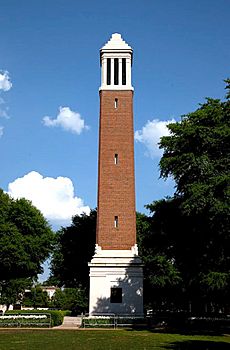
The University of Alabama is the largest university in the state. It has about 40,000 students. It has been a part of Tuscaloosa since it opened in 1831. Stillman College is a historically black college. It opened in 1875 and has about 1,200 students. Shelton State Community College is also in the city. It is one of the largest community colleges in Alabama, with about 4,000 students.
Schools for Kids
The Tuscaloosa City School System serves the city. It has about 10,300 students in 24 schools. These include 13 elementary schools, 6 middle schools, and 3 high schools. There are also two special schools: a vocational school and a school for students with special needs.
The Tuscaloosa County School System serves the areas outside the city. It has about 18,000 students in 34 schools. These include 6 high schools, 8 middle schools, and 19 elementary schools.
Tuscaloosa also has several private schools. These include Tuscaloosa Academy and Holy Spirit Catholic School.
Media and News
The Tuscaloosa News is the main daily newspaper in the city. It also publishes websites like tuscaloosanews.com. The Planet Weekly is a local alternative newspaper. Each college also has student-run newspapers, like The Crimson White at the University of Alabama.
Kids Life Magazine is a free magazine about family-friendly events in Tuscaloosa.
Tuscaloosa is part of a larger television market. All major TV networks have channels here. WVUA-CD 7 is the only TV station that broadcasts from Tuscaloosa. It is owned by the University of Alabama.
Tuscaloosa is also a radio market. There are many radio stations playing different types of music and talk shows. Alabama Public Radio, the state's largest public-radio network, has its main studios at the University of Alabama.
Transportation
Tuscaloosa is connected to other parts of the country by air, rail, and road. The city is located where several major highways meet. These include US 11, US 43, US 82, I-20, and I-59. Interstate 359 goes from I-20/I-59 into downtown Tuscaloosa.
Trains and Buses
Amtrak provides passenger train service to Tuscaloosa. The Crescent line connects the city to major cities along the East Coast, from New York City to New Orleans. Freight train services are also available.
Greyhound Bus Lines offers bus service to Tuscaloosa. The Tuscaloosa Transit Authority runs the Tuscaloosa Trolley System. The University of Alabama has its own bus service called CrimsonRide.
Airport
The Tuscaloosa National Airport (KTCL) is just northwest of the city. It is owned by the City of Tuscaloosa. It has two runways and provides services for private planes, cargo flights, and flight training. The airport helps the local economy by about $48.6 million each year.
Port of Tuscaloosa
The Port of Tuscaloosa is a river port on the Black Warrior River. It is managed by the Alabama State Port Authority. The Black Warrior River has a system of locks and dams. These allow barges to travel all the way up to Birmingham. This connects Tuscaloosa to the Gulf Coast port of Mobile. It also connects to the Ohio River valley through the Tenn-Tom Waterway. The port mainly handles dry goods like coal.
Notable People
(B) means the person was born in Tuscaloosa.
Arts and Entertainment
- Hannah Brown, (B) Miss Alabama USA 2018; TV star on The Bachelorette
- Rick Bragg, Pulitzer Prize-winning author
- Willie D. Burton, (B) sound technician for movies; won Academy Awards
- Chase Coleman, (B) actor in HBO's Boardwalk Empire
- Charlie Hayward, (B) musician, bass guitarist for the Charlie Daniels Band
- Watt Key, (B) author known for Alabama Moon
- Chuck Leavell, musician for The Allman Brothers Band and The Rolling Stones
- Brandon Scott, (B) actor in Grey's Anatomy and The Last of Us
- Dylan Riley Snyder, (B) actor in Broadway's Tarzan and TV's Kickin' It
- Dinah Washington, (B) blues and jazz singer; in the Rock and Roll Hall of Fame
Sports Stars
- Tim Anderson, (B) Major League Baseball player
- Bear Bryant, famous Alabama coach
- Sylvester Croom, (B) first African-American head football coach in the Southeastern Conference
- Otis Davis, (B) Olympic track and field athlete; won two gold medals in 1960
- George Foster, (B) Major League Baseball player
- Kirani James, Olympic gold medalist in 400m
- Billy Neighbors, (B) football player for University of Alabama and NFL
- David Robertson, baseball pitcher for New York Yankees
- John Stallworth, (B) football player for Pittsburgh Steelers; won four Super Bowls
- Deontay Wilder, (B) boxer, former WBC World Heavyweight Champion
Other Notable People
- Sylvia Hitchcock, Miss Alabama USA 1967, Miss USA 1967 and Miss Universe 1967
- James Spann, meteorologist
- Jimmy Wales, co-founder of Wikipedia
Sister Cities
Tuscaloosa has special relationships with cities in other countries. These are called sister cities:
See also
 In Spanish: Tuscaloosa (Alabama) para niños
In Spanish: Tuscaloosa (Alabama) para niños
Images for kids




